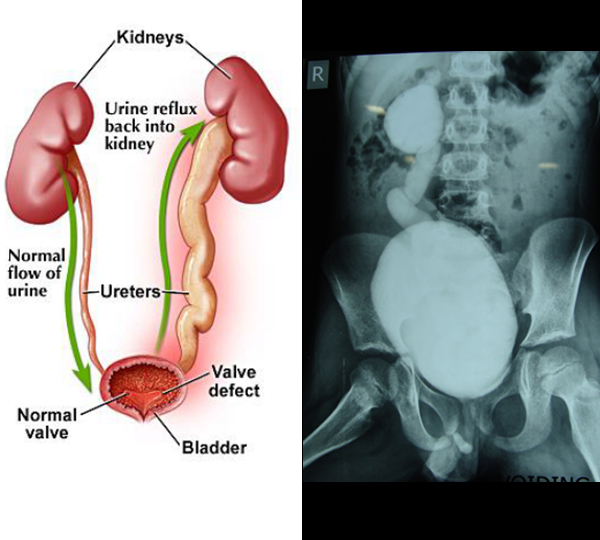
Vesico-ureteric reflux (VUR)
Vesico-ureteric reflux (VUR) occurs when the valve between the ureters (the tubes that carry urine away from the kidneys) and the bladder is not working properly. Urine can flow backwards into the ureters, sometimes as far as the kidneys. If infected urine flows into the kidneys, this can damage them.
VUR occurs in about one in every 100 children. It is more common in girls than in boys.
If one child in a family has VUR, there is a chance that the other children could have VUR too, so brothers and sisters might be monitored. VUR is usually diagnosed in under fives.
It is much less common in older children, who may have outgrown the problem.
What causes vesico-ureteric reflux?
In many children, the tunnel through the bladder wall is not long enough, so the valve does not work properly, but this can improve as the child grows.
In some children, the ureters enter the bladder in a higher position than normal, which also means that the valve does not work properly. This is less likely to improve as the child grows.
Other children, particularly boys, may have a blockage in the urethra (posterior urethral valves) causing VUR.
What are the signs and symptoms of vesico-ureteric reflux?
Sometimes VUR can be diagnosed before birth when an ultrasound scan shows that one or both of a baby's kidneys look swollen and larger than usual (hydronephrosis).
When VUR is diagnosed after birth, it is usually suspected if a child has repeated urine infections.
Symptoms of a urine infection can include:
- burning sensation during urination
- urinating more often than usual
- abdominal pain
- a high temperature
- vomiting
- reduced appetite or foul smelling urine
If a child has VUR, urine infections can damage the kidneys, as the urine flowing backwards towards them contains bacteria. Kidney damage can cause high blood pressure in later life or if untreated, may lead to kidney failure.
How is vesico-ureteric reflux normally diagnosed?
VUR is diagnosed and monitored using two particular scans:
- Ultrasound scans are used to diagnose hydronephrosis before birth and to check the structure of the bladder, ureters and kidneys after birth.
- The other test is called a micturating cysto-urethrogram (MCUG). This uses a liquid that shows up on x-rays, which is put inside the bladder through a catheter (thin, plastic tube) inserted into the urethra. Once the bladder is full of this liquid, the child urinates while being scanned. This shows whether all the liquid is being passed through the urethra, or whether any of it is flowing backwards through the ureters towards the kidneys.
The MCUG test is also used to 'grade' the degree of reflux, according to its severity. Grade 1 is the least severe form of VUR, where urine is flowing back up the ureters but is not reaching the kidneys. Grade 5 is the most severe, where a great deal of urine is reaching the kidneys, making the ureter and kidney swollen.
VUR is also described as 'unilateral' or 'bilateral' depending on whether one kidney (unilateral) is affected or both (bilateral).
How is vesico-ureteric reflux normally treated?
At Children's Urology Hospital, we aim to treat VUR using medicines at first. Usually, a low dose of antibiotics is given on a long-term basis, often until the child is two to three years old.
This prevents urinary tract infections, which in turn, prevents any damage to the kidney caused by infected urine flowing backwards into them. Treatment with antibiotics gives many children the opportunity to outgrow VUR.
Children with VUR who are taking antibiotics will sometimes need to give regular urine samples, to be checked for any urine infections, particularly at an early stage. Ultrasound scans are often used to check that the kidneys are growing properly.
Children who continue to have urinary tract infections despite the antibiotics, or still have severe reflux after the age of five years old, might need an operation.
There are two types of procedure:
- Endoscopic injection - a tube containing a small camera and a light is inserted into the bladder, enabling the surgeon to then inject material into the ureter to repair the valve. The child will need a general anaesthetic but, as it is an outpatient procedure, they should be able to return home the same day.
- Ureteric reimplantation - this is a more invasive procedure that involves disconnecting the ureters from the bladder and re-attaching them at the correct angle to create a valve. The child will require a short stay in hospital while they recover.
Can vesico-ureteric reflux be prevented?
Avoiding urine infections is very important in vesico-ureteric reflux. You should encourage the child to:
- drink plenty of fluids
- go to the toilet regularly (every three to four hours)
- eat plenty of wholegrain cereals, bread, fruit and vegetables to avoid constipation
For some boys, a circumcision (where the foreskin of the penis is removed) can help reduce infections.
What is the success of surgery?
If the correction is done by Deflux Injection, success is around 70%. Success by open surgery is nearly 97-98%.

